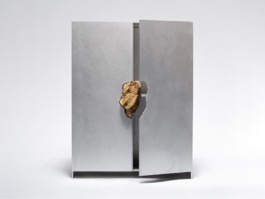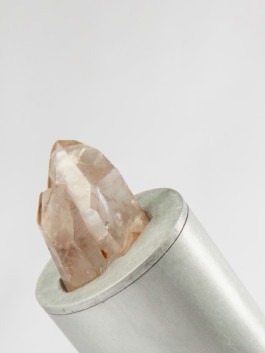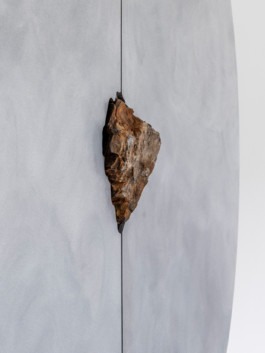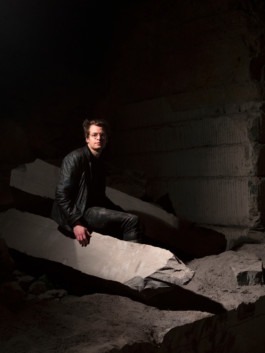



Pierre De Valck (Belgium). Cabinet with stone (Petrified wood), 2020. Metal, wood. Image © Pierre De Valck.
Pillow Talk
Pierre De Valck x Studio Argot
17 May 2021
Pillow Talk is the latest concept from COLLECTIBLE In-Depth. This series of articles instigates design encounters in a playful setting. The idea is simple: we pair designers from the Curated Section and each duo then freely chooses three questions to ask to each other. They can tackle any subject, within the realm of design - or not! Today’s duo Pierre De Valck and Ryan Eimear from Argot studio.
Pierre De Valck: Many of your recent visuals are set in non-existent yet very intriguing digital landscapes/interiors/architectures. How does the design of these scenic settings come about? What inspires you and how important is the creation of such a scene to you?
Studio Argot: I suppose it's related to my background in interior design, thinking about the overall spatial design and always thinking about an ideal scenario or space an object or furniture could fit into. Yes, it's important but it's also incredibly fun and since it's digitally created, for me, it's more, ‘Why not create an imaginary space with fun architecture’? I could just redraw my apartment in Paris but it's just not as fun :). Also, I find that when I do this, something unexpected always comes from it, as I get carried away and start designing custom pieces for an imaginary space, and often come back to them later and develop them.
“ How important, in your experience, is your person(a) to marketing your work/product?”
PDV: How important, in your experience, is your person(a) to marketing your work/product?
SA: This is a good question - and one I'm still figuring out myself. For sure my primary way of communicating my work to the world is via Instagram, and with that comes a certain expectation/opportunity to share more than just the design pieces but also yourself, your inspirations and even some aspects of your personal life. For example when I feel inspired by a designer's work, I find myself scrolling through their account to find out more about them as a person. I guess it's human nature, or perhaps just a sign of the times.
PDV: What have been some of the biggest challenges for you in starting your studio and what have been some of the important lessons you took away from your experience?
SA: Oh there are a lot! I will try to be concise :) Firstly, it's an obvious one, which is starting a studio when French isn't your first language, in France, where the amount of paperwork alone can put you off. I also found it hard to ask for help and tend to want to do every aspect myself, then I discovered collaboration and how enriching it can be. An important lesson I still need to remember is that it's a marathon, not a sprint and while I have to work hard, not everything can be done at once, prototypes take time, building and improving the aesthetic takes time, basically to chill out a little and not be so impatient!

Studio Argot, ANDREA BRESCIANI. Image © Studio Argot

Pierre De Vlack. Floor lamp with crystal, 2021. Crystal, aluminium. Image © Pierre De Vlack.
Studio Argot: What drew to your material choices?
Pierre De Valck: Pierre De Valck furniture wishes to harness ancient geological forces in a contemporary bodice. To harvest the passing of time in the now and thus create relevant ‘Modern Antiquities’ that retell the story of our collective past. In the series “Pieces with Stone” for instance, each piece is encrusted with a rare (semi-precious) stone of exceptional historical value. The choice of materials can be considered both decorative as well as minimalistic, aesthetic as well as substantive. A raw stone fragment has gracefully survived all of human history - no cultural feat or historical trend could tarnish its image. And so, in its own unique fashion, it represents an authentic testimony to the formation of the very earth we walk on and from which we extract all our raw materials and minerals. And yet any stone, without a backdrop or carrier, is but a stone. Decorum at its best, but mostly rather banal. Pierre De Valck furniture is made to reintroduce these invaluable mineral jewels to our daily life with a sense of dignity and humility, so it may live to tell the tale… The metals used to construct the furniture are mostly chosen for their complementary, subservient character, intrinsic beauty and exceptional durability. The metals are manually treated to a cloudy appearance - a delicate process that cannot be imitated by any industrial procedure. An homage to historical craftsmanship and what it could mean in our day and age.
“ The key is perhaps in being very knowledgeable about both, remaining explorative and open for the possibilities and consciously considering the right dosage, more so than choosing one over the other.”
SA: Since your pieces are unique, made by hand, and the stones have a certain precious quality; how do you feel when you have to part them?
PDV: Each piece is a unique objet trouvé in its own right, carrying the energy of both ancient and modern-day labor, as if it were millions of years in the making. A lot of care and precision goes into making each piece exactly right - from finding the right stone to its positioning within the cabinet, shaping the cabinet according to the organic form, manually assembling the piece and applying the finishing. So far, the people that have sought out Pierre De Valck furniture have had such a profound appreciation for and understanding of each piece that I, besides the inevitable tad of sadness, mostly felt grateful upon parting with it. Oddly enough, it often feels like ‘giving back’ a bit, too.
SA: Do you think the design world's developing digital presence could/will change how you design in the future?
PDV: The world is indeed evolving into a digitalized reality where AI is at the heart of how most things are organized to the extent that modern society can hardly be conceived without it. And yet, in principle, as humans, we do what we’ve always done: we look for the most sophisticated tools available to create the most wondrously beautiful things possible. And then we optimize and improve, evolve and move on (which, today, is happening at exponential speed). I believe our generation is offered an incredible amount of richesse, both digital and analogue - the key is perhaps in being very knowledgeable about both, remaining explorative and open for the possibilities and consciously considering the right dosage, more so than choosing one over the other. As the market seems to be shifting towards digital consumerism in general, so is the consumption of art and design itself. Sooner or later, its production and conception will (have to) follow. Pierre De Valck has yet to hop on that train fully, but I’m eager to explore the potential of this new fictional reality.

Pierre De Valck, Round cabinet with stone (petrified wood), 2021, image ©Pierre De Valck.

Studio Argot, ANDREA BRESCIANI. Image © Studio Argot.

Studio Argot portrait. Image © Studio Argot
About Studio Argot (France)
An Irish designer based in Paris, Eimear Ryan founded Argot Studio in 2018. Her practice focuses on furniture, object, and spatial design. Since her first collection handmade in oak by her father, the studio has been researching into and experimenting with, new sustainable materials for furniture design.

Pierre De Valck portrait. Image © Pierre De Valck.
About Pierre De Valck (Belgium)
Fascinated since childhood by archaeology and collecting historical artefacts, Ghent-based designer Pierre De Valck creates unique pieces attempting to harness the power of ancient geological processes in a contemporary setting. These “Modern antiquities” act as authentic testimonies of our collective memory.
Pillow Talk
Pierre De Valck x Studio Argot
17 May 2021

Pierre De Valck (Belgium). Cabinet with stone (Petrified wood), 2020. Metal, wood. Image © Pierre De Valck.
Pillow Talk is the latest concept from COLLECTIBLE In-Depth. This series of articles instigates design encounters in a playful setting. The idea is simple: we pair designers from the Curated Section and each duo then freely chooses three questions to ask to each other. They can tackle any subject, within the realm of design - or not! Today’s duo Pierre De Valck and Ryan Eimear from Argot studio.
Pierre De Valck: Many of your recent visuals are set in non-existent yet very intriguing digital landscapes/interiors/architectures. How does the design of these scenic settings come about? What inspires you and how important is the creation of such a scene to you?
Studio Argot: I suppose it's related to my background in interior design, thinking about the overall spatial design and always thinking about an ideal scenario or space an object or furniture could fit into. Yes, it's important but it's also incredibly fun and since it's digitally created, for me, it's more, ‘Why not create an imaginary space with fun architecture’? I could just redraw my apartment in Paris but it's just not as fun :). Also, I find that when I do this, something unexpected always comes from it, as I get carried away and start designing custom pieces for an imaginary space, and often come back to them later and develop them.
“ How important, in your experience, is your person(a) to marketing your work/product?”
PDV: How important, in your experience, is your person(a) to marketing your work/product?
SA: This is a good question - and one I'm still figuring out myself. For sure my primary way of communicating my work to the world is via Instagram, and with that comes a certain expectation/opportunity to share more than just the design pieces but also yourself, your inspirations and even some aspects of your personal life. For example when I feel inspired by a designer's work, I find myself scrolling through their account to find out more about them as a person. I guess it's human nature, or perhaps just a sign of the times.
PDV: What have been some of the biggest challenges for you in starting your studio and what have been some of the important lessons you took away from your experience?
SA: Oh there are a lot! I will try to be concise :) Firstly, it's an obvious one, which is starting a studio when French isn't your first language, in France, where the amount of paperwork alone can put you off. I also found it hard to ask for help and tend to want to do every aspect myself, then I discovered collaboration and how enriching it can be. An important lesson I still need to remember is that it's a marathon, not a sprint and while I have to work hard, not everything can be done at once, prototypes take time, building and improving the aesthetic takes time, basically to chill out a little and not be so impatient!

Studio Argot, ANDREA BRESCIANI. Image © Studio Argot

Pierre De Vlack. Floor lamp with crystal, 2021. Crystal, aluminium. Image © Pierre De Vlack.
Studio Argot: What drew to your material choices?
Pierre De Valck: Pierre De Valck furniture wishes to harness ancient geological forces in a contemporary bodice. To harvest the passing of time in the now and thus create relevant ‘Modern Antiquities’ that retell the story of our collective past. In the series “Pieces with Stone” for instance, each piece is encrusted with a rare (semi-precious) stone of exceptional historical value. The choice of materials can be considered both decorative as well as minimalistic, aesthetic as well as substantive. A raw stone fragment has gracefully survived all of human history - no cultural feat or historical trend could tarnish its image. And so, in its own unique fashion, it represents an authentic testimony to the formation of the very earth we walk on and from which we extract all our raw materials and minerals. And yet any stone, without a backdrop or carrier, is but a stone. Decorum at its best, but mostly rather banal. Pierre De Valck furniture is made to reintroduce these invaluable mineral jewels to our daily life with a sense of dignity and humility, so it may live to tell the tale… The metals used to construct the furniture are mostly chosen for their complementary, subservient character, intrinsic beauty and exceptional durability. The metals are manually treated to a cloudy appearance - a delicate process that cannot be imitated by any industrial procedure. An homage to historical craftsmanship and what it could mean in our day and age.
“ The key is perhaps in being very knowledgeable about both, remaining explorative and open for the possibilities and consciously considering the right dosage, more so than choosing one over the other.”
SA: Since your pieces are unique, made by hand, and the stones have a certain precious quality; how do you feel when you have to part them?
PDV: Each piece is a unique objet trouvé in its own right, carrying the energy of both ancient and modern-day labor, as if it were millions of years in the making. A lot of care and precision goes into making each piece exactly right - from finding the right stone to its positioning within the cabinet, shaping the cabinet according to the organic form, manually assembling the piece and applying the finishing. So far, the people that have sought out Pierre De Valck furniture have had such a profound appreciation for and understanding of each piece that I, besides the inevitable tad of sadness, mostly felt grateful upon parting with it. Oddly enough, it often feels like ‘giving back’ a bit, too.
SA: Do you think the design world's developing digital presence could/will change how you design in the future?
PDV: The world is indeed evolving into a digitalized reality where AI is at the heart of how most things are organized to the extent that modern society can hardly be conceived without it. And yet, in principle, as humans, we do what we’ve always done: we look for the most sophisticated tools available to create the most wondrously beautiful things possible. And then we optimize and improve, evolve and move on (which, today, is happening at exponential speed). I believe our generation is offered an incredible amount of richesse, both digital and analogue - the key is perhaps in being very knowledgeable about both, remaining explorative and open for the possibilities and consciously considering the right dosage, more so than choosing one over the other. As the market seems to be shifting towards digital consumerism in general, so is the consumption of art and design itself. Sooner or later, its production and conception will (have to) follow. Pierre De Valck has yet to hop on that train fully, but I’m eager to explore the potential of this new fictional reality.

Pierre De Valck, Round cabinet with stone (petrified wood), 2021, image ©Pierre De Valck.

Studio Argot, ANDREA BRESCIANI. Image © Studio Argot.

Studio Argot portrait. Image © Studio Argot
About Studio Argot (France)
An Irish designer based in Paris, Eimear Ryan founded Argot Studio in 2018. Her practice focuses on furniture, object, and spatial design. Since her first collection handmade in oak by her father, the studio has been researching into and experimenting with, new sustainable materials for furniture design.

Pierre De Valck portrait. Image © Pierre De Valck.
About Pierre De Valck (Belgium)
Fascinated since childhood by archaeology and collecting historical artefacts, Ghent-based designer Pierre De Valck creates unique pieces attempting to harness the power of ancient geological processes in a contemporary setting. These “Modern antiquities” act as authentic testimonies of our collective memory.
Contact
info@collectible.design
VIP PORTAL
EXHIBITOR PORTAL
PRIVACY POLICY
© 2025 Collectible
Contact
info@collectible.design
VIP PORTAL
EXHIBITOR PORTAL
PRIVACY POLICY
© 2025 Collectible